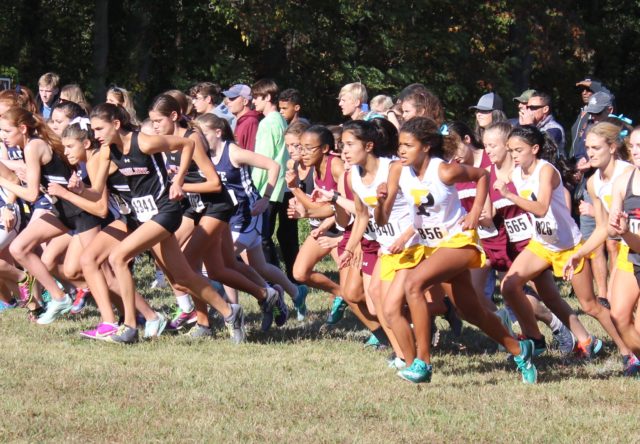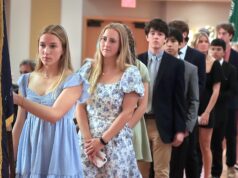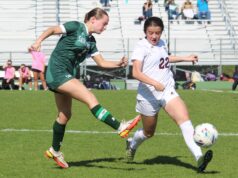
Athletes who play fall sports in high schools in Delaware will return to the practice field on Sept. 28, with competition beginning Oct. 19 after the Delaware Interscholastic Athletic Association executive board voted for the return of athletics at its meeting on Sept. 10. The vote will need to be approved by the state Board of Education when it convenes on Sept. 17.
The DIAA, under pressure from parents and with additional guidance from the state Division of Public Health, voted for the new calendar by a 14-2 vote with one abstention. That came after nearly three and a half hours of presentations and debate about safety protocols, transportation, competition dates and several other subjects.
The biggest difference in circumstances between Thursday’s vote and the decision made Aug. 6 to delay sports until December was the approval of the Division of Public Health to allow football. Two board members admitted during the meeting that the lack of football played a part in their decision to vote against fall sports last month.
The board recommended a 12-game maximum season for volleyball, soccer and field hockey, from 15 to 12, and nine competition dates for cross country. Football will play a seven-game season, with four teams advancing to the state tournament for both Divisions I and II.
Bradley Bley, the medical representative, said the reason for shortening the seasons was not because football had to shorten its season, but because they wanted to limit the other sports to two games per week for medical reasons.
Participants in fall sports except cross country will have to wear masks during competition. The other option was to not wear masks but play under modified rules. In soccer, for example, that would mean no corner kicks, sliding tackles or headers, and no player other than the goalkeeper allowed in the six-yard box. Other accommodations also are being made for the coronavirus pandemic.
‘It’s either we modify rules, or we use masks and we don’t modify the rules,” DIAA executive director Donna Polk said.
She and others on the board emphasized that game officials and coaches will have to play their part in making sure the protocols are being followed.
Bley said the epidemiologist for Public Health will have to decide whether a team has to shut its season down in the case of a positive COVID test. The board acknowledged the risk in restarting sports, but said the advantages outweigh the negatives.
“It’s a risk of life. It’s not just sports,” Bley said.
Board director Bradley Layfield said DIAA has asked the Division of Public Health for statistics about outbreaks at club sports that were in operation all summer and have continued into the fall. He has not heard back, but believes there has not been a problem.
“There really isn’t anything that has broken out that we’re aware of. I think we would have heard about it if there had been an outbreak,” he said.
John Wilson, the football coach at St. Georges Tech and president of the Delaware Interscholastic Football Coaches Association, said the organization believes the sport can be played safely, as it happening in other states. Many local teams have been working out for months.
“The great thing about this is that we’ve been doing this since July 6. If you came out to our practices, the only difference is we’re not wearing pads,” said Wilson, the former coach at Saint Mark’s High School.
Nine schools, he continued, have had 4,500 screenings of athletes and coaches, and they have not reported one positive test.
Layfield addressed the feedback received from parents, athletes and others around the state in the last month. He said DIAA had received 184 emails from 150 different addresses, from public, private and charter school representatives. Of those, seven emails supported the decision to delay athletics.
Many details will need to be worked out over the next month by athletic directors and other officials. Jeremy Jeanne, athletic director at Delaware Military Academy, noted that most schools do not have turf fields, and more than half do not have lights. That could become a factor if the weather worsens and as the amount of daylight decreases, particularly after clocks are moved back.
The DIAA decision covers varsity, junior varsity and middle school sports, but whether all levels play will be up to individual schools, districts and conferences. Public Health must approve site-specific plans for indoor facilities, including gymnasiums and weight rooms, and any play days also must get the OK.
The decision to participate in athletics is up to each district. They have until Oct. 1 to notify DIAA if they will not be fielding teams, and that decision will stand for the entire 2020-21 year. In a survey of districts across the state, three indicated that they will not have interscholastic sports this year, although they were not named. The board did not address what would happen if athletes in those schools wanted to transfer.
As for students who are attending school remotely, the board said as long as they logged in for class or asynchronous learning, they would be eligible to play that day.
Kevin Fitzgerald, superintendent of the Caesar Rodney School District, said having sports will require a lot of work from all involved. Transportation will be a main concern, and some buildings are still shut down completely. Several superintendents preferred a starting date later in October.
“This will be a heavy lift for everyone involved,” Fitzgerald said. “The question keeps coming up: Why can we do something after 3 o’clock, but not do something after 7 in the morning? We can do things on the athletic field that we can’t do in the classroom, and that’s frustrating to the superintendents and it’s frustrating to the parents.”
Mike Hart, the athletic director emeritus at Salesianum School and author of the proposal eventually adopted by the DIAA board, agreed that it will take hard work, but he expressed confidence in the state’s athletic directors to make it happen.
“It’s going to be extremely tough no matter what we do. I think the bottom line is, in my opinion, is the DIAA, we are involved in athletics, and that has to be our main focus,” he said.







